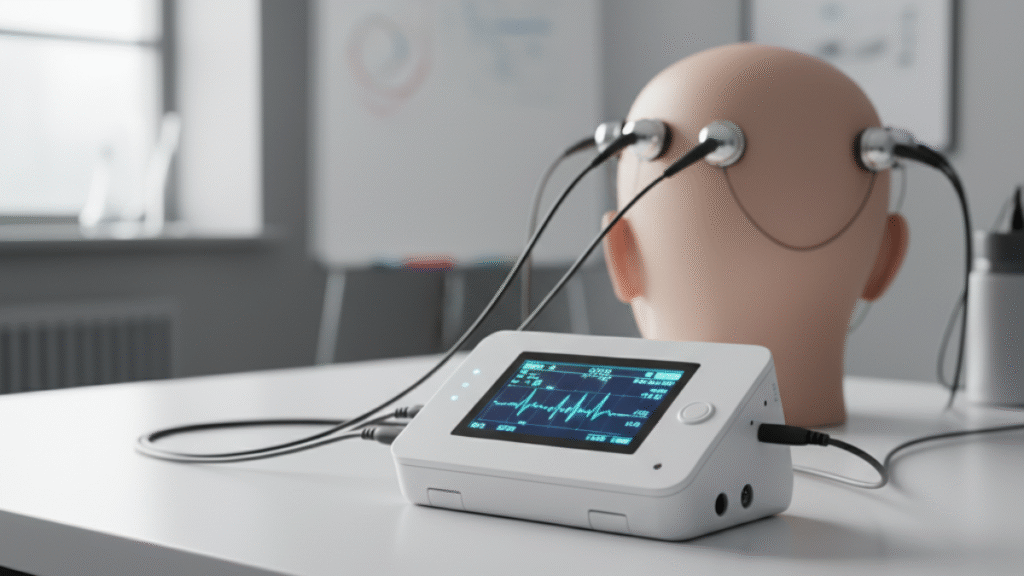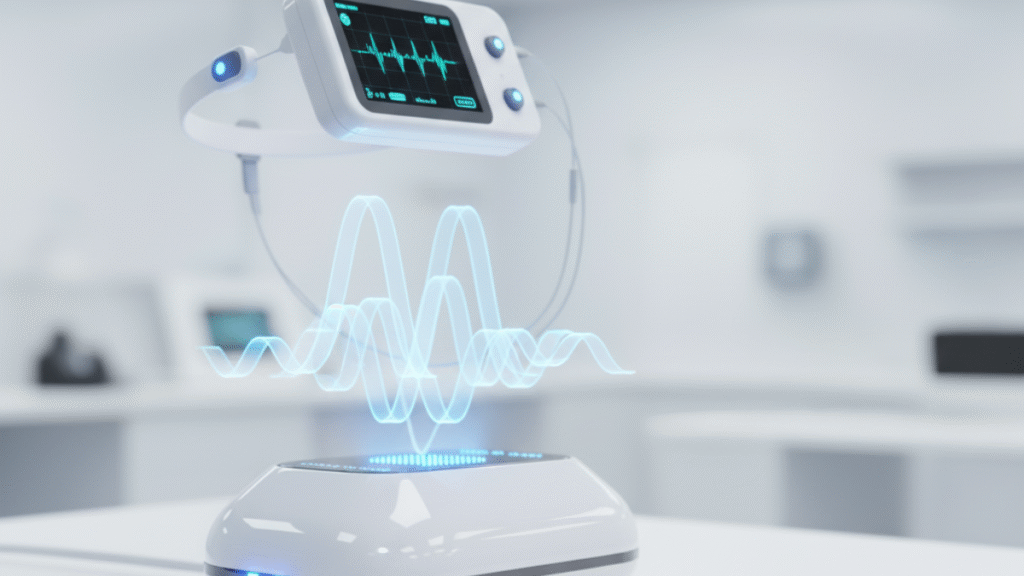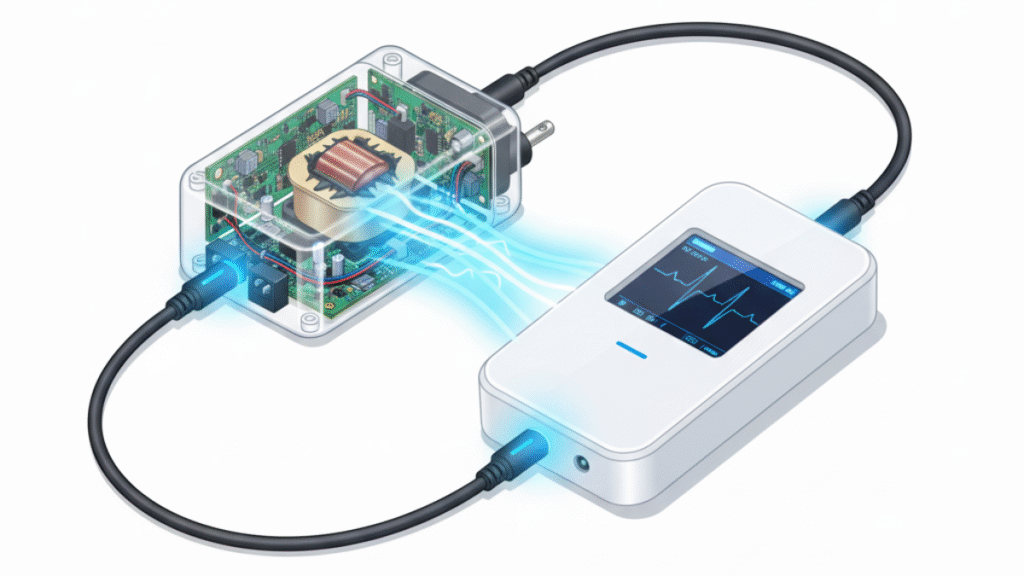With the advancement of modern medical technology, portable medical devices are gradually becoming part of people’s lives. Particularly in the fields of brain science and neuromonitoring, portable electroencephalogram (EEG) monitors are gaining increasing attention from medical institutions and researchers due to their flexibility, portability, and real-time monitoring capabilities. These devices not only record EEG signals but also provide crucial support for data analysis and health management. However, the reliable operation of any high-precision electronic device depends on a stable power supply. In the world of portable EEG monitors, power adapters play an irreplaceable role.
Power adapters not only provide the voltage and current required by the device but also directly impact signal acquisition accuracy, device lifespan, and safety. This article will explore in detail the relationship between portable EEG monitors and power adapters, from technical principles to design considerations and future developments, presenting a comprehensive picture of the collaborative work between technology and energy.
What is a Portable EEG Monitor?
EEG monitoring is a technology that analyzes neural function by recording brain electrical activity. Traditional EEG devices are typically bulky and stationary in hospitals or laboratories, but portable EEG monitors overcome these limitations. With its lightweight design and flexible wearability, it enables real-time monitoring and data collection, providing greater opportunities for scientific research and medical treatment.
A portable EEG monitor primarily consists of the following components: sensors and electrodes for capturing EEG signals; a signal processing unit for amplifying, filtering, and converting the signals; and a data storage or display module for recording or presenting the monitoring results. These components must work closely together to ensure accurate and consistent signal acquisition. Problems in any of these links can compromise the quality of the final data.
One of the challenges in device design is power consumption and power management. EEG signal acquisition requires high-precision, high-frequency data processing, and continuous operation consumes significant energy. Furthermore, to ensure portability, devices typically cannot be equipped with batteries with excessively large capacity. This requires the power adapter to provide stable power while also being lightweight and safe.

The Role of the Power Adapter in a Portable EEG Monitor
The power adapter is one of the core power sources for electronic devices. For portable EEG monitors, it not only replenishes the battery but also ensures stable operation. The main functions of a power adapter include providing stable voltage and current, protecting the device from current fluctuations and overloads, and extending the device’s lifespan.
Portable medical devices place stringent requirements on power adapters. Safety is paramount. Medical environments have extremely high electrical safety standards, and power adapters must provide overcurrent, overvoltage, and short-circuit protection to ensure safety during use, without endangering the patient or the device. Stability is also a key consideration. EEG signal acquisition is highly sensitive, and voltage fluctuations or unstable current can lead to increased signal noise or data loss. Finally, portability is key. The adapter’s size, weight, and interface type must be suitable for the portable device’s use scenario while ensuring long-term durability.
A faulty power adapter can cause a variety of problems, including device startup failure, data acquisition interruption, excessive battery loss, and even device damage. Therefore, selecting the right power adapter is crucial for ensuring the performance of portable EEG monitors.
The power adapter and battery work in a synergistic relationship. The adapter provides continuous power to the device, while the battery ensures continued operation during power outages or during mobile use. The accuracy of the adapter’s output voltage and the stability of its current directly impact the quality of EEG signal acquisition and also determine the device’s lifespan and reliability.
Coordinating the Design of Portable EEG Monitors and Power Adapters
During the device design phase, matching the power adapter with the EEG monitor is a key consideration. First, power matching is crucial. The device’s required voltage and current must match the adapter’s output; otherwise, overload or power shortages may occur. Designers typically select the appropriate adapter specifications based on the device’s operating current and voltage fluctuation range.
Overload and short-circuit protection are also key considerations. Power adapters often include internal circuit protection components to prevent damage to the device due to voltage spikes or short circuits. Especially in medical devices, such protection not only protects the device but also directly affects the safety of patients and users.
Interface type and adapter size are also important factors in coordinating the design. Portable EEG monitors have stringent interface design requirements, ensuring efficient current transmission while also being easy to connect and disconnect. Furthermore, the adapter’s size and weight must balance portability and avoid burdening the user.
The coordinated design of the power adapter and device not only involves hardware compatibility but also optimizes overall system performance. For example, high-precision power regulation can reduce power supply noise, thereby improving the signal-to-noise ratio (SNR) of EEG signal acquisition. A good design can also extend battery life and reduce energy loss during mobile use.

The Impact of the Power Adapter on Device Environmental Adaptability
Portable EEG monitors often need to operate in a variety of environments, including those with varying temperatures, humidity, vibration, and power grid stability. In these situations, the stability and adaptability of the power adapter are particularly important.
Temperature fluctuations significantly impact electronic components. High temperatures can cause overheating of the adapter’s internal components, affecting output voltage stability; low temperatures can increase resistance and reduce current output efficiency. Excellent power adapters typically feature temperature compensation and heat dissipation designs to ensure a stable power supply even in extreme environments.
Humidity and power grid fluctuations are also influencing factors. Excessive humidity can cause circuit shorts or corrosion, while an unstable power grid can generate voltage fluctuations, interfering with EEG signal acquisition. Modern adapters use protective designs and voltage regulation technologies to ensure the device operates properly in complex environments.
Power interface and connection stability are also critical during vibration and mobile use. The adapter must ensure a stable power supply even during slight shaking or transport to avoid interrupting data acquisition or damaging the device. Optimizing the adapter’s structure and interface design can significantly improve device reliability in portable environments.
The power adapter is not only a power provider but also a key component of the device’s environmental adaptability. Only with high stability and compatibility can a portable EEG monitor achieve continuous and high-precision data acquisition.

Technology Trends and Future Outlook
With technological advancements, portable EEG monitors and power adapters are constantly being optimized and upgraded. Power adapter trends include miniaturization, high efficiency, intelligent management, and wireless power supply technology. Miniaturization and lightweighting can further enhance the comfort of portable devices; high-efficiency designs reduce energy loss and extend battery life; and intelligent management can dynamically adjust voltage and current to optimize signal acquisition and device life.
Wireless charging and intelligent power management systems will provide greater flexibility for future devices. Wireless power delivery reduces physical interface limitations and improves device portability. Intelligent power management systems dynamically adjust output power based on the device’s operating status, ensuring stable data acquisition and extending battery life.
For EEG monitors, the future trend is toward lighter weight, higher accuracy, and longer battery life. With continuous improvements in sensor technology, signal processing techniques, and data analysis algorithms, portable EEG monitors will be able to provide higher-precision monitoring in a smaller form factor while balancing battery life and adapter efficiency.
The combination of high-performance and intelligent power adapters will provide more reliable energy for medical research, health monitoring, and home medical devices, laying the foundation for the widespread adoption and development of portable EEG monitoring technology.
Usage Recommendations
When selecting a portable EEG monitor and power adapter, consider safety, compatibility, and reliability. First, ensure the adapter has the necessary safety certifications, such as CE, UL, or RoHS. Second, select the appropriate adapter based on the device’s voltage, current, and interface requirements to ensure power compatibility and avoid damage. Finally, consider after-sales service and durability, choosing an adapter that offers long-term stable operation.
During daily use, keeping the adapter clean and free of moisture and overheating is crucial for ensuring long-term, stable operation of the device. Regularly checking the condition of the interface and cable can also prevent power supply issues caused by aging or damage. Proper usage and maintenance strategies can effectively extend the device’s lifespan and ensure the continuity and accuracy of EEG signal acquisition.
Conclusion
Portable EEG monitors represent the trend toward portability and intelligence in modern medical equipment, and the power adapter is the core guarantee for the stable operation of this technology. Their close integration ensures high-precision data acquisition while ensuring the device’s reliability and safety in a variety of environments.
From device design and collaborative optimization to technological development, the power adapter has always played an irreplaceable role. In the future, with the continuous advancement of intelligent and high-efficiency technologies, portable EEG monitors will become even lighter and more accurate, while power adapters will also become smaller, smarter, and more energy-efficient, providing solid power support for medical and health management. Focusing on the stable power behind this technology is a key entry point for understanding the performance and safety of portable EEG monitors.




